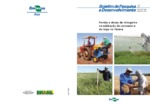Please use this identifier to cite or link to this item:
http://www.infoteca.cnptia.embrapa.br/infoteca/handle/doc/1008455| Title: | Fontes e doses de nitrogênio na adubação de semeadura do trigo no Paraná. |
| Authors: | FOLONI, J. S. S.  BASSOI, M. C.   OLIVEIRA JUNIOR, A. de   CASTRO, C. de   |
| Affiliation: | JOSE SALVADOR SIMONETI FOLONI, CNPSO; MANOEL CARLOS BASSOI, CNPSO; ADILSON DE OLIVEIRA JUNIOR, CNPSO; CESAR DE CASTRO, CNPSO. |
| Date Issued: | 2014 |
| Citation: | Londrina: Embrapa Soja, 2014. |
| Pages: | 34 p. |
| Description: | RESUMO: Objetivou-se com este trabalho avaliar a aplicação de N nos sulcos de semeadura do trigo, a partir de diferentes doses com as fontes ureia, ureia tratada com inibidor de urease (ureia+NBPT) e nitrato de amônio, em comparação à adubação nitrogenada de cobertura, em duas localidades representativas das macrorregiões tritícolas (MRTs) 1 e 3 do Paraná. Os experimentos foram conduzidos na safra de 2011, em Ponta Grossa (MRT 1) e Londrina (MRT 3). Ambos foram instalados no delineamento em blocos completos ao acaso, no esquema fatorial 3x3x2 mais dois tratamentos complementares, da seguinte forma: ureia, ureia+NBPT e nitrato de amônio com as doses de 20, 40 e 80 kg ha-1 de N na semeadura, combinadas com 0 e 80 kg ha-1 de N em cobertura; mais dois tratamentos complementares, sem N-adubo (semeadura e cobertura) e somente 80 kg ha-1 de N em cobertura. O nitrato de amônio é a fonte nitrogenada mais segura para aplicação nos sulcos de semeadura do trigo. Há risco significativo de toxicidade às plantas quando a ureia é utilizada na adubação de base da lavoura. O NBPT minimiza o impacto negativo da ureia. Indica-se aplicar de 20 a 40 kg ha-1 de N na adubação de semeadura do trigo. O modo de aplicação de N influencia fortemente o acamamento. Os máximos rendimentos de grãos são alcançados com doses de N relativamente baixas. As características edafoclimáticas das macrorregiões tritícolas 1 e 3 do Paraná influenciam o manejo do N. ABSTRACT: The objective was to evaluate the application of N in wheat sowing with different levels of urea, urea + NBPT (urease inhibitor) and ammonium nitrate, comparing with the topdressing nitrogen fertilization, in two sites of wheat macro-regions (WMR) 1 and 3 of Paraná, Brazil. The experiments were carried out during 2011 agricultural year in Ponta Grossa (WMR 1) and Londrina (WMR 3). Two experiments were designed as randomized complete block, and the treatments were arranged in a 2x3x3 factorial design with four replications, as follows: urea, urea + NBPT and ammonium nitrate applied with the levels of 20, 40 and 80 kg ha-1 N in sowing, and were combined with the presence and absence of topdressing fertilization with 80 kg ha-1 N; and two additional treatments without N-fertilizer and only 80 kg ha-1 N in topdressing. Ammonium nitrate is the safest nitrogen source for application in wheat sowing. There is significant risk of toxicity to plants when urea is used in crop sowing fertilization. NBPT reduces the negative impact of urea. The recommendation is 20 to 40 kg ha-1 N in wheat sowing fertilization. The way to apply of N influences the lodging of the wheat plants. The maximum grain yield is obtained with N rates relatively low. The soil and climatic characteristics of the wheat macro-regions 1 and 3 of Paraná influence the management of N. |
| Thesagro: | Trigo Adubação |
| NAL Thesaurus: | Wheat Nitrogen fertilizers |
| Series/Report no.: | (Embrapa Soja. Boletim de Pesquisa e Desenvolvimento, 8). |
| ISSN: | 2178-1680 |
| Type of Material: | Folhetos |
| Access: | openAccess |
| Appears in Collections: | Boletim de Pesquisa e Desenvolvimento (CNPSO)  |
Files in This Item:
| File | Description | Size | Format | |
|---|---|---|---|---|
| BoletimPD81.pdf | 480,93 kB | Adobe PDF |  View/Open |









